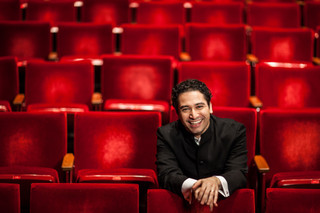|
Back
Shock and Awe Houston
Jones Hall
05/12/2015 -
Pyotr Ilyich Tchaikovsky: Symphony No. 5 in E Minor, Op. 64 – Piano Concerto No. 1 in B-flat Minor, Op. 23
Lang Lang (piano)
Houston Symphony, Andrés Orozco-Estrada

A. Orozco-Estrada (© Julie Soefer)
"Lang Lang joins Andrés," as this special Houston Symphony event was billed, seems a bit of a misnomer. The evening revolved around the superstar pianist, from the oversized ovations as he entered and exited the stage to the upending of the concerto-symphony programming paradigm.
The silver lining is that those who might have just come to experience Lang Lang were treated to Andrés Orozco-Estrada's excellent reading of Tchaikovsky's Fifth Symphony. While his recent Bartók Concerto for Orchestra lacked a distinctive profile, personality oozed from every bar of the Tchaikovsky symphony. The common elements of Orozco-Estrada's style -rhythmic precision, exaggeration of contrasts in each score, and uncanny agility at tough transitional spots - were augmented in this red-hot performance by an engaging, unique interpretive stance that made for a monumental ride.
The first movement's con anima marking could be felt throughout, even in the second theme, the tempo of which was as pliable as could be. The second movement brought ravishing playing, with William VerMeulen doing what he does best in the famous horn solo and the strings producing an enormously rich sound at the climax. Even Orozco-Estrada's faithfulness to Tchaikovsky's indications didn't result in much feeling of "con alcuna licenza", an indication that is hardly ever played up. The heightened romanticism of the slow movement contrasted wonderfully with the balletic agility of the Valse. Here, too, wind solos were excellent, and the strings scurried about in perfect unison. The finale was icing on the cake, the brass delivering massive walls of sound, always with excellent blend and intonation.
Lang Lang entered to thunderous applause and took that tempestuous energy straight to the keyboard. Displaying his trademark theatrical virtuosity, his playing and mannerisms are indeed stunningly mesmerizing. His overabundance of technique and personality, however, are put at the service at self and not at the service of the music. Indeed, there wasn't much difference between his treatment of Prokofiev's Third Concerto, Tchaikovsky's First, or his encore: Mozart's Rondo alla turca from the K. 331 Sonata. Never missing an opportunity to melodramatically sweep his hands away from the most virtuosic gesture, to look longingly up to the sky as if begging the heavens for the right interpretive answer, or to thunderously pound out perfectly-placed octaves at dizzying speeds, this is self-gratifying showmanship at its most extreme.
What is most bothersome about this approach is that Lang Lang's extravagant display is so expected. The juxtaposition of the massive, hyper-Romantic Tchaikovsky concerto and the Classical Mozart encore, played in the same manner, with the same range of articulation, same hyperboles and same choreography, made everything seem, well, the same.
In the concerto, there was a lack of organic connection between keyboard, podium and orchestra. Tempos were in conflict from the outset, Lang Lang adopting a more rapid pace for his chords after the orchestra's incipit. Likewise, before the first cadenza in the opening movement, those impressive thunderous octaves were shot forth faster the the orchestral precedent, the pianist seeming to want to show off his technique rather than continue the musical line. The entire affair was less a "joining" of piano and orchestra, rather a separation of two musical personalities that just happen to be starting and ending the same piece at the same time.
There is clearly a large, enthusiastic audience for this type of piano playing, and they got exactly what they came for. For this listener, though, the members of the HSO and Orozco-Estrada were the true stars of the evening.
Marcus Karl Maroney
|